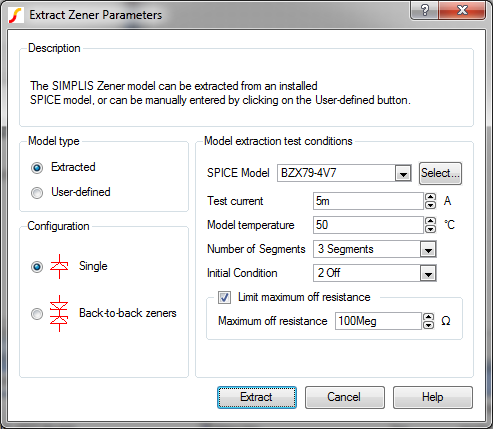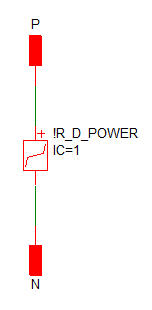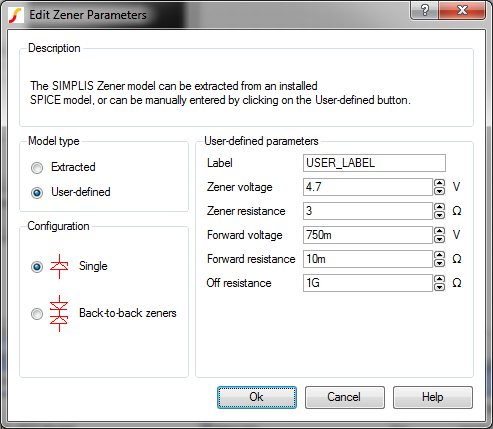SIMPLIS Parts
|
Any SPICE zener model installed in the SIMetrix library can be converted for use in SIMPLIS. When a zener is placed on a SIMPLIS schematic, a model parameter extraction routine is invoked to automatically convert the SPICE model to a SIMPLIS model. During the model parameter extraction process, SIMetrix/SIMPLIS automatically runs several SPICE simulations on the SPICE model and extracts the SIMPLIS model parameters. After the Piecewise Linear (PWL) model parameters have been extracted, the resulting zener model will run in SIMPLIS.
The extracted zener model can then be used to create a model for one of two zener configurations:
| Configuration | Description |
| Single | A single zener |
| Back-to-back zeners | Two zeners in series but with opposite polarities, creating a bidirectional clamp. |
These zener configurations are more than a convenience, SIMPLIS will run faster with these models, and run into less problems with errors.
In this Topic Hide
When you place a Zener symbol on a schematic, the Extract Zener Parameters dialog opens for you to edit the default test conditions. The default test conditions are defined using the command shell menu File ▶ Options ▶ SIMPLIS Options.... For additional information, see SIMPLIS Zener Options.

The following table describes the Extract Zener Parameters dialog test conditions.
| Test Condition | Default Value | Units | Description |
|---|---|---|---|
SPICE Model |
BZX79-4V7 |
|
The SPICE model used to extract SIMPLIS parameters. |
Model type |
Extracted |
|
Invokes the model parameter extraction algorithms. |
| Test current | 5m |
A |
The peak forward and reverse current used for curve fitting. The algorithm fits a straight line between 50% and 100% of this value. |
| Model temperature | 50 |
°C |
Temperature used for all extraction simulations. |
| Number of Segments | 3 |
|
Zener Diodes may have two segments - representing Zener Resistance and Off Resistance or three segments with the third segment representing the transition between the Zener and Off states. |
| Initial Condition | 2 Off |
Sets initial conducting segment. |
|
| Limit maximum off resistance | Checked |
none |
Limits the off resistance for the diode. For some SPICE models, this will produce a SIMPLIS model which runs faster. |
| Maximum off resistance | 100Meg |
W |
The maximum off resistance of the diode. This value is used only if the "Limit maximum off resistance" checkbox is Checked. |
SIMPLIS extracts a model based on the parameters in the Extract Zener Parameters dialog. Although the zener model is internally saved as ASCII text, the following illustration shows the model in a schematic form.
Below is a schematic view of the zener model:
| The Zener models this circuit element | Schematic |
||
|
 |
The user-defined model uses parameters entered directly in the Edit Zener Parameters dialog without invoking the model extraction algorithms. A Zener can be switched from an extracted model to a user-defined model at any point; however the extracted parameters are by default copied over to the user-defined parameters, replacing any user-entered values. You can disable this behavior in the SIMPLIS Options by clearing the check box labeled Automatically copy extracted parameters to User-defined parameter. You can access these options from the command shell menu File ▶ Options ▶ SIMPLIS Options.... For more information, see SIMPLIS Zener Options.

Parameters |
Default Value |
Units |
Description |
|---|---|---|---|
Label: |
USER_LABEL |
|
Any descriptive text. Cannot contain whitespace characters. |
| Model type: | User-defined | The values in this dialog are used literally. | |
| Zener voltage: | 4.7 | V | The Zener voltage. The zener diode effectively turns on in the reverse direction at this voltage. |
| Zener resistance: | 3 | W | The zener resistance at voltages higher than the Zener voltage. |
| Forward voltage: | 750m | V | Zener forward voltage drop. The zener diode effectively turns on in the forward direction at this voltage. |
| Forward resistance: | 10m | W | The zener resistance at voltages higher than the Forward voltage. |
| Off Resistance: | 1G |
W | The resistance of the zener at voltages less than the Forward voltage. |
| Models these circuit elements | User-defined Schematic |
||
|
 |
You can customize or manually generate your own zener models using a parameter string with multiple PARAM_NAME=PARAM_VALUE key-value pairs. The parameter names and their functions are described in the Zener Model Parameters section below. You can interpret the SIMPLIS parameter values from device datasheet specifications and curves.
You can compose the parameter string in a text editor, spreadsheet, or script. The order of the parameter names in the parameter string and the capitalization of the parameter names are irrelevant.
You can include a PROTECTED=1 key-value pair to prevent from extracting a model and overwriting your manually generated parameters. The PROTECTED=1 key-value pair is not used in the simulation.
Note: When you
click on the device after adding the PROTECTED=1 key-value pair, the following
message box appears to warn you that this is a hand-edited model.

To customize or generate your own zener model, follow these steps:
Alternately you can write the PARAM_VALUES property to the symbol using
the Prop command in the command line with the following syntax:
prop PARAM_VALUES parameter_string
where parameter_string is the set of
key-value pairs that you created in Steps 1
and 2 above. Since parameter_string contains spaces, the entire
string must be enclosed in double quotes.
The following tables detail the parameters which define the electrical behavior of the Zener model. Several other parameters in the PARAM_VALUES property have no effect on the electrical behavior of the model. These parameters are used to populate the Extract Zener Parameters dialog box.
Note: The default values are unlikely to appear in an extracted model. If these parameter values appear in your design, there has been an error in composing the parameter string.
Conduction Model
Zeners are modeled in SIMPLIS with Piecewise Linear (PWL) resistors. The PWL segments are represented by X,Y points
| Parameter Names | Default Value | Description | |
| NUMSEG | 3 | Number of segments in the zener model.
|
|
| V0 | ID0 | 1.123456789 | X-Y point definitions for zener:
|
| V1 | ID1 | 1.123456789 | |
| V2 | ID2 | 1.123456789 | |
| V3 | ID3 | 1.123456789 | |
| V4 | ID4 | 1.123456789 | |
| V5 | ID5 | 1.123456789 | |
| V6 | ID6 | 1.123456789 | |
© 2015 simplistechnologies.com | All Rights Reserved